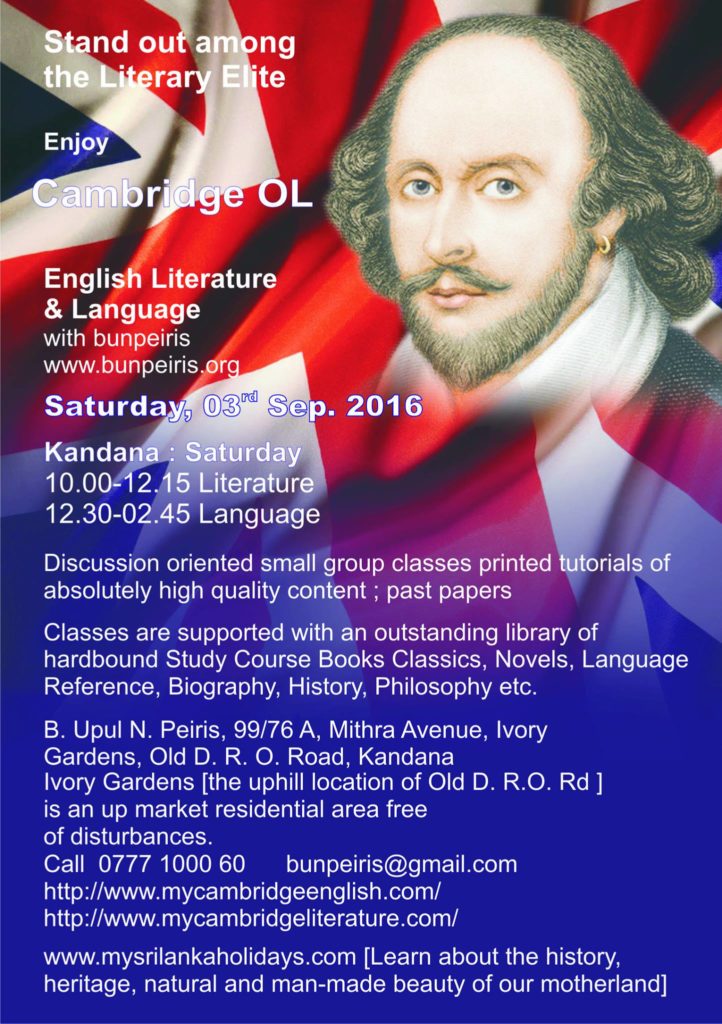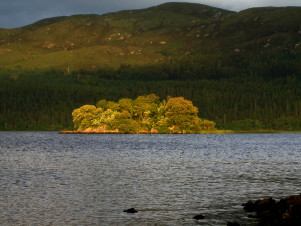Lake Isle of Innisfree

Lake Isle of Innisfree
Lake Isle of Innisfree, of all the poems prescribed in Sri Lanka National OL Literature, is the of simplest and loveliest little poem for all of you budding poets & lovers of literature or rather humanity, to cut your teeth, i.e. to sharpen your sensibilities to literature. Lake Isle of innisfree is the ideal launch pad to take wing into appreciation of poems & even other works of literature. And then again the reason too is the loveliest and simplest: it speaks right into our hearts.
If so was then, worse is now
See, Yeats wrote this poem in the late nineteenth century, far from our twentyfirst century. Now imagine, even at that point in time, he profoundly feels contrast between hustle and bustle of urban life and serenity of the country life.
Today, perhaps, we feel even more strongler than Yeats had felt, yet we find us incapble of writing so eloquntly, so poetically of an isolated spot in an uninhabited lake island.
Who among us, the city dwellers, wouldn’t dream of living in a serene atmosphere of the countryside, by a lake, by the greenery, by the bees?
Who among us, could ever fail to fall into the love of the sweetest of all honeys: bee honey?
Around us are all chaos caused by greed. In spite of the flaming chaoes, we are forever in entangled in nature. Hearts of ours do leap at the beauty of the nature; heartthrob of ours do rhyme with the nature. The humanity being one with nature, in our heart of heart we all yearn for the peace, the deepest of all, the peace with nature. Then again, sunk in our greed, we seek to secure profit by mother nature, resulting in pathetic hostility towards the very nature of the nature.
Broader the mind, simpler the world is
The wonder is this lovely little poem ‘Lake Isle of innisfree’ that appeals to the youngest of the students of literature wasn’t at all written by a writer of children’s literature. It was written by a supremely profound mind: no less a personage than a Nobel Laureate in the form of William Butler Yeats (1865 – 1939).
Written by bunpeiris
|
The Lake Isle of Innisfree by W. B. Yeats
I will arise and go now, and go to Innisfree, And I shall have some peace there, for peace comes dropping slow, I will arise and go now, for always night and day |
The persona seems to be determined to leave city and visit the countryside. I will arise! And go now! And go to Innisfree! The poem begins with the person’s determination to visit the Lake Isle of Innisfree, yet in the end, we don’t see him anywhere close. All of a sudden we realize that the person is still in the city: standing on a grey pavement of a road. Well, perhaps he would never visit the Lake Isle of Innisfree. |
The Lake Isle of Innisfree Glossary
Glossary is bound to make the poem much easier to follow
wattles: sticks woven together to make fences
glade: an open space, without trees, in a forest
veils: shadows
cricket: a small brown insect
all a glimmer: shines softly
linnet’s wings: flying songbirds
lapping: moving gently with a soft sound
in the deep heart’s core: in the depth of the heart
ELEMENTS OF THE POEM
PERSONA [Author’ assumed character in his work of literature]:
The poet- Yeats himself
THEME [Subject or theme] [main idea or concern in a story or poem. It refers to the comment the author is making about the charaters and situation in the work of literature]:
Nature brings peace and harmony to humanity. The humanity could be one with the nature.The poet himself yearns to escape from the urban surroundings and find sanctuary in the scenic countryside.
AIM [Moral values – lessons we can learn from a story of poem- imparted to the readers]:
All of us need to return to nature, where we all have begun to find peace and tranquility.
We ought to learn to appreciate the beauty of nature.
SETTING [The immediate surroundings, a position or manner in which a thing is set, ] [the time, place & social environment of the drama, story or poem] – it usually tells the readers when, where and what happens in a story]:
The physical setting is a peaceful Irish countryside. Keywords that reflect this are: Lakeside,cabin, glade, wattles, lapping
The setting also reeals the hours of the day:
Morning- veils of the morning
Day- nine bean rows, honey bee
Evening-purple glow, cricket sings
Night-midnight’s all a glimmer
TONE [Attitude of the persona in the poem. It arises from the way personagives voice. The tone is also reflected in the diction or choice of words]:
Peaceful
MOOD [State of mind]:
In line with the theme of the poem, the tone of the poem is thoughtful, expectant, & harmonius. The lines that reflect the mood are
I shall have some peace there,
for peace comes drooping slow
STRUCTURE & STYLE [Literary devices]:
Imagery [use of vivid, descriptins to create an image or word picture. These words or phrases ususally appeal to the five senses] this poem has strong visual [appeal to eyes] & auditory [appeal to ears] imagery
Visual imagery:
veils of the morning; metaphor for the fog of early morning, or the mist, the dew on the morning grass.noon a purple glow;
evening full of linnet’s wings makes us think not only of one bird, but also of all of them in flight.
Auditory imagery:
bee-loud glade, cricket sings, lake water lapping
Metaphor [A way of comparing two or more things without using the words ‘like’ or ‘as’]
Peace comes drooping slow
veils of the morning :Metaphor for the fog of early morning, or the mist, the dew on the morning grass.
Midnight’s all a glimmer
I hear it in the deep heart’s core: metaphor for the part of the speaker that feels and dreams deeply.
ALLITERATION [The repetition of consonant sounds]
Lake water lapping with low sounds
ASSONANCE [Repetition of identical or simlar vowel sounds in the stressed syllables (& sometimes in the following unstressed syllables) of neighbouring words.
I will arise and go now & go to Innisfree
cricket sings
onnon a purple glow
and evening full of the linnet’s wings
nine bean rows will I have there, a hive for the honey bee
a small cabin build there of cly and wattle made
low sounds by the shore
I hear it in the deep hearts’ cire
and live alone in the bee loud glade
for peace comes dropping slow
ONOMTOPOEIA [The use of words that seem to imitate the sound they refer to (whack, fizz, crackle, his) ]
dropping, lapping
REPETITION
In this poem, some words, sounds and lines are repated so that certain ideas sounds and moods can be stressed
‘I will go now’
for peace comes dropping slow, Dropping from the veils
STRUCTURE & STYLE
The Lake Isle of Innisfree is writen in three stanzas.
Each stanza has four lines.
The rhyme schme in this poem is ABAB: the last word in line 1 rhymes with the last word in line 3
| stanza | line | word | line | word | |
| 1 | 1 | Innisfree | 3 | bee | |
| 1 | 2 | made | 4 | glade | |
| 2 | 1 | slow | 3 | glow | |
| 2 | 2 | sings | 4 | wings | |
| 3 | 1 | day | 3 | grey | |
| 3 | 2 | shore | 4 | core |
“The Lake Isle of Innisfree,” published in Yeats’s second book of poems, 1893’s The Rose, is one of his first great poems, and one of his most enduring. The tranquil, hypnotic hexameters recreate the rhythmic pulse of the tide. The simple imagery of the quiet life the speaker longs to lead, as he enumerates each of its qualities, lulls the reader into his idyllic fantasy, until the penultimate line jolts the speaker—and the reader—back into the reality of his drab urban existence: “While I stand on the roadway, or on the pavements grey.” The final line—“I hear it in the deep heart’s core”—is a crucial statement for Yeats, not only in this poem but also in his career as a whole. The implication that the truths of the “deep heart’s core” are essential to life is one that would preoccupy Yeats for the rest of his career as a poet; the struggle to remain true to the deep heart’s core may be thought of as Yeats’s primary undertaking as a poet.
sparknotes.com/poetry/yeats/section1.html
Q & A for you guys who sit for Sri Lanka National O.L. Literature.
Q: How does the poet describe the tranquility of The Isle of Innisfree?
A. Yeats, the poet deribes the traquility of the Lake Isle of Innisfree by narrating the sights and sound of the scenery and atmosphere. The sounds of crickets chirpng make the mornings peaceful while the the flapping of the linnets as they fly around the island makes the evenings too make the Lake Isle of Innisfree tranquil.
Q. Do you think The Lake Isle of Innisfree is always in the mnd of the poet?
A. The Lake Isle of Innisfree is always in the mind & heart of the poet:”I hear it in the deep heart’s core”. In his mind, he always imagines pleasant sounds of its water:” for always night and day I hear it lapping with low sounds by the shore”
Even while he walks along in the street, he recalls the Lake Isle of Innisfree: “while I stand on the roadway, or on the pavements grey, I hear it”
Q. How does the poet celebrate the beauty of the Lake Isle of Innisfree?
A. The poet celebrates the beauty of the Lake Isle of Innisfree by narrating the transiet visual aspects of the sceneary rather than the narrating the landscape. He describes the glitter of the starlingt & moonlight reflected in the water in the evening as well as the purple glow of the heather in the sunlight.
Q. What kind of person is the poet?
A. Loves and appreciated nature, longs for solitude and a peaceful existence, wishes too escape the modern living and return to basic life style, day dreamer, creative, imaginative???? Explain your own words.
Following is additional information for students of literature sitting for
Sri Lanka National OL Literature
I say additional information since it isn’t necessary for you to get to know about the author so that perhaps you would easily see the message that the poet strives to pass onto the reader. [This isn’t the case most often]
However, you shouldn’t be concerned of writer’s intentions. All you have to do is read the poem The Lake Isle of Innisfree couple of times and give voice to what you think of the poem. It is your opinion that is valued. But then in all events, in all works of literature, you must support your perspective, your opinion, your point of view with the text concerend, i.e. in this case with the lines of the poem, The Lake Isle of Innisfree.
Above method of examination is based on the concept of literary apprecaition called “Reader Response Theory.” You are the reader; you may respond on your own, tell all what you think. Have no fear. [nihil timendum est] National OL English Literature as well as Cambridge OL & IGCSE follows the same concept in examinations.
Literature as a discipline is strongly affected by subjectivity and individuality.
The teaching approach should not by any means limit the students’ originality, stifle their imaginative involvement or cramp their style of writing turn literary study into a production of answers on the same basic model.
Students should be encouraged to read for themselves, discover and write responses, which will make them, think for themselves rather than depend on someone else for a response.
H.R.S.K.Atugoda, Director/English, Department of English, National Institute of Education, Maharagama, January 2010
William Butler Yeats
William Butler Yeats (/ˈjeɪts/; 13 June 1865 – 28 January 1939) and James Augustine Aloysius Joyce (2 February 1882 – 13 January 1941), two of Ireland’s most respected writers, were most influential voices to ever integrate into British literature. Though both were respected for their work, they had different ways of introducing Ireland and its culture. One congratulates her fighters, while the other dramatizes the corruption and other immoral behaviors that reside within her.
W. B. Yeats, one of the foremost literary luminaries of 20th century literature, was a beacon of light and enlightenment of Ireland, his motherland, who went into serve as an Irish Senator for two terms. Yeats was a driving force behind the Irish Literary Revival and, along with Lady Gregory,Edward Martyn, and others, founded the Abbey Theatre, where he served as its chief during its early years. In 1923, he was awarded the Nobel Prize in Literature. W. B. Yeats, as the Nobel Committee described, “inspired poetry, which in a highly artistic form gives expression to the spirit of a whole nation.”
Nobel Prize even before the finest works of lierature
Yeats is generally considered one of the few writers who completed their greatest works after being awarded the Nobel Prize; such works include The Tower (1928) and The Winding Stair and Other Poems (1929).
Friends of Yeats
Yeats was a very good friend of American expatriate poet and Bollingen Prize laureate Ezra Pound. It was Yeats who wrote the introduction for the God of Poem [Rabindranath Tagore]’s Gitanjali, which was published by the India Society.
The featured image herein is another lovelist Irish lake reproduced by kind courtesy of Wikimedia Commons.
Origin of “The Lake Isle of Innisfree” by W. B. Yeats, from his Autobiography
I had [in London] various women friends on whom I would call towards five o’clock mainly to discuss my thoughts that I could not bring to a man without meeting some competing thought, but partly because their tea and toast saved my pennies for the bus ride home; but with women, apart from their intimate exchanges of thought, I was timid and abashed. I was sitting on a seat in front of the British Museum feeding pigeons when a couple of girls sat near and began enticing my pigeons away, laughing and whispering to one another, and I looked straight in front of me, very indignant, and presently went into the Museum without turning my head towards them. Since then I have often wondered if they were pretty or merely very young. Sometimes I told myself very adventurous love-stories with myself for hero, and at other times I planned out a life of lonely austerity, and at other times mixed the ideals and planned a life of lonely austerity mitigated by periodical lapses. I had still the ambition, formed in Sligo in my teens, of living in imitation of Thoreau on Innisfree, a little island in Lough Gill, and when walking through Fleet Street very homesick I heard a little tinkle of water and saw a fountain in a shop-window which balanced a little ball upon its jet, and began to remember lake water. From the sudden remembrance came my poem “Innisfree,” my first lyric with anything in its rhythm of my own music. I had begun to loosen rhythm as an escape from rhetoric and from that emotion of the crowd that rhetoric brings, but I only understood vaguely and occasionally that I must for my special purpose use nothing but the common syntax. A couple of years later I could not have written that first line with its conventional archaism — “Arise and go” — nor the inversion of the last stanza.
Lake isle of Innisfree Photo credits:Steve Wickham
========================================================
Following is furthermore additional information. If you read this article for the purposes of Examination of Sri Lanka National OL Literature, and if you guess you could be confused, you may ignore this section with an advertisment.
Today the natural beauty of Lake isle of Innisfree is encroached by the man.
See how the advertiser appeal to country lovers living in the urban surroundings.
SALE
Allotments at Lake Isle of Innisfree

LICENSED AUCTIONEERS & SOLE AGENTS
IRISH PROPERTIES · SPECIALISED IN RESIDENTIAL PROPERTY
|
Have you ever wanted to own a piece of lakeshore property for your family and yourself to enjoy? Are you living near a lake and wanted to own your own ground and access onto the water? Are you living in a city with no green around you and miss that your children have no connection to nature? Are you living far away from water and like the outdoor lifestyle, camping? Do want to invite your friends to a BBQ on your own lakeshore property? They are located on the shores of Sligo’s Lough Gill at Trawane Bay near the famous Lake Isle of Innisfree. The area is designated as area of natural beauty. Allotments of this type are relative new to the Irish market but have proofed a great success with our fellow European citiziens. Most major European lakes offer such properties and are very sought after and appreciated. They are on exclusive offer by the above agents. |





